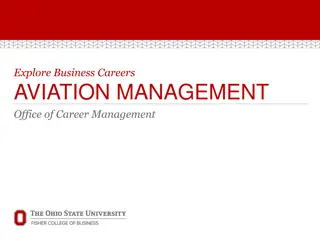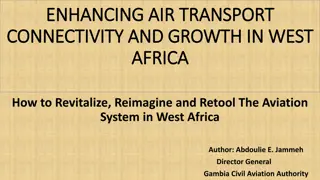Enhancing Aviation Safety Through Broadened Operational Insights
Explore innovative strategies to enhance aviation safety through a widened scope of operational perspectives. Gain insights from expert Dr. Jon Holbrook of NASA on expanding the field of vision in aviation. Popular
1 views • 15 slides
Geospatial Comparison of Economic Change and Climate Disasters in Asia-Pacific
This study explores the impact of natural disasters on economic indicators in Southern and Western Asian countries over time, aiming to assist in policy-making by understanding the relationship between natural disasters and the economy. It discusses the increasing incidences of extreme weather event
4 views • 18 slides
South Sudan Civil Aviation Authority Overview
South Sudan Civil Aviation Authority (SSCAA) was established in 2012 to regulate the aviation industry in South Sudan. As a member of ICAO, SSCAA aims to provide efficient, safe, secure, reliable, and affordable aviation infrastructure and services. Challenges include financial autonomy and meeting
1 views • 10 slides
Development Dynamics of Aviation Networks in Zimbabwe
Aviation plays a crucial role in Zimbabwe's economic growth, with the government focusing on infrastructure development to position the country as a regional aviation hub by 2030. Initiatives include strengthening civil aviation systems, enhancing airport infrastructure, and prioritizing safety and
3 views • 15 slides
NEAT: Nexgen ERAM Adaptation Tool for Federal Aviation Administration
NEAT, the Nexgen ERAM Adaptation Tool, is a versatile application by the Federal Aviation Administration for viewing, manipulating, and exporting aviation data. It allows users to manage grids, filter data, and access various files including NFDC Subscriber files and Canadian AIXM data. The tool fac
3 views • 36 slides
The Importance of Safety Expertise in Aviation Engineering
Safety expertise plays a crucial role in aviation engineering to prevent catastrophic failures. Dr. Mallory Suzanne Graydon from NASA Langley Research Center emphasizes the significance of historical aviation safety incidents, the need for redundancy in parts, and the importance of safety analyses l
4 views • 18 slides
Understanding the Relationship Between Intangible Cultural Heritage and Disaster Risk Reduction
This PowerPoint presentation by UNESCO explores the connection between Intangible Cultural Heritage (ICH) and Disaster Risk Reduction (DRR). It covers key concepts like disasters, risks, vulnerabilities, and resilience, emphasizing the importance of safeguarding and mobilizing ICH in the face of dis
7 views • 23 slides
Understanding Natural Disasters and Their Causes
Explore the various types of natural disasters such as meteorological, geophysical, hydrological, climatological, and biological events, each with unique causes like storms, earthquakes, floods, droughts, wildfires, and more. Learn how these disasters impact the environment and living organisms.
9 views • 16 slides
Enhancing Aviation Safety Through Human Contributions
The NASA System Wide Safety Project Initiative focuses on transforming aviation through new technologies and policies to enhance safety. The Human Contributions to Safety (HC2S) Initiative highlights the vital role of people in maintaining aviation safety. Despite human error being a factor in many
0 views • 25 slides
Understanding Psychological First Aid in Times of Disasters
Explore the psychological impact of disasters, learn the common reactions, and understand the core actions of Psychological First Aid (PFA). Discover how stress and disasters affect communities and individuals, common reactions to disaster stress, and when professional help may be needed.
0 views • 42 slides
Understanding Agricultural Risk Management in the Face of Natural Disasters
Exploring the impact of natural disasters on agricultural economics, this content delves into the challenges faced by farmers and the approaches available for managing risks. From analyzing the Billion-Dollar Disasters in the US to discussing private and public risk management provisions, the conten
3 views • 20 slides
Impact of Federal Policies on the Aviation Industry During COVID-19
Analysis of COVID-19 policy effects on the aviation industry, including passenger demand changes, regulatory flexibilities, financial support provided, and implications of various governmental actions. Data presented includes shifts in passenger and freight traffic, regulatory actions by the FAA, an
0 views • 11 slides
Understanding Different Types of Disasters and Their Impact
Disasters, whether natural or man-made, can cause massive disruptions leading to human suffering, economic loss, and environmental damage. Natural disasters like earthquakes and cyclones, geological disasters such as volcanic eruptions, hydrological disasters like tsunamis, and climatological disast
0 views • 11 slides
Strategic Communications for NASA Earth Applied Sciences Disasters Program
NASA's Earth Applied Sciences Disasters Program aims to enhance disaster prediction, preparedness, response, and recovery through Earth observations. The program utilizes strategic communications to raise awareness about disaster impacts and the importance of NASA's work. It emphasizes the role of h
1 views • 14 slides
Understanding NOTAMs in Aviation: A Comprehensive Guide
Delve into the world of NOTAMs - Notice to Airmen - and discover their significance in aviation operations. From what a NOTAM is to why they are essential, this guide covers the purpose, importance, format, and accountability of NOTAMs in ensuring aviation safety and awareness. Explore the building
0 views • 27 slides
Understanding Chemical Disasters in the Indian Chemical Industry
Chemical disasters pose a significant threat to the Indian chemical industry, impacting human lives, property, and the environment. Factors contributing to these disasters include ageing process plants, human errors, design defects, and natural events. Proper prevention measures, such as hazard iden
0 views • 13 slides
The Aviation Learning Center: Empowering Hawaii's Workforce
The Aviation Learning Center (ALC) at the Pearl Harbor Aviation Museum offers an immersive hands-on learning experience for students of various age groups, focusing on aviation concepts and practical applications. The program includes educational modules, flight simulators, and a curriculum aligned
0 views • 7 slides
Explore Careers in Aviation Management
Aviation management involves overseeing flight operations and preparing students for professional positions in the aviation industry. Success in this field requires adaptability, communication, critical thinking, problem-solving, teamwork, and the ability to work under pressure. Sample roles include
0 views • 8 slides
Transition of Legacy CONUS Area Forecasts in Aviation Weather Modernization
On June 15, 2017, the National Weather Service announced a transition plan to retire legacy CONUS Area Forecasts (FAs) and adopt improved aviation weather products and services. The transition period will last three months, with full implementation expected by October 10, 2017. The goal is to enhanc
5 views • 9 slides
Challenges and Solutions in Water-Related Disasters
Exploring the global and Asian challenges posed by water-related disasters, this presentation by Kenzo Hiroki delves into the importance of investing in disaster risk reduction. Highlighting the increasing frequency and impact of natural disasters, particularly those related to water, the images and
0 views • 28 slides
Man-made Disasters: Short-term Events and Long-term Consequences
Man-made disasters come in two main forms: short-term events like oil spills or nuclear accidents, and long-term consequences such as climate change and loss of biodiversity. This article covers incidents like the Westgate Bridge Catastrophe in Melbourne and the Tasman Bridge Collapse in Hobart, hig
0 views • 24 slides
Quality System for the Aviation Data in ICAO
International Civil Aviation Organization (ICAO) is responsible for collecting, analyzing, and disseminating statistics related to civil aviation. The quality system for aviation data ensures relevance, accuracy, timeliness, accessibility, comparability, and coherence of the collected data. ICAO's s
0 views • 7 slides
The Role of Psychology in Aviation Safety Culture
Psychology plays a crucial role in building a culture of aviation safety by studying and preempting the psychological stressors faced by aviation staff. Aviation psychology focuses on human behaviors, cognitive functioning, and emotional processes in the complex aviation environment, with a history
0 views • 24 slides
Role of Aviation in Tourism Liberalisation and Development
Explore the significance of aviation in tourism liberalisation through insights on the International Transport Forum, tourism impact on GDP, employment, and exports, tourists' preferences for freedom in air travel, and a comparison of aviation with other tourism services. The content delves into the
0 views • 12 slides
Health Impact Assessments for Natural Disaster Recovery
The study examines the status of knowledge related to health impact assessments for natural disaster recovery, emphasizing the importance of considering the long-term health impacts of disasters. It highlights how disasters and recovery actions can have lasting consequences on community health and w
0 views • 10 slides
Enhancing Air Transport Connectivity and Growth in West Africa: Strategies for Revitalizing the Aviation System
Abdoulie E. Jammeh, Director General of Gambia Civil Aviation Authority, discusses the pre-COVID-19 achievements in the aviation sector in West Africa and the current/future challenges faced due to the pandemic. The article emphasizes on revitalizing, reimagining, and retooling the aviation system b
0 views • 6 slides
Enhancing Aviation Career Opportunities in Singapore
Promoting aviation careers in Singapore is a priority for the Civil Aviation Authority of Singapore (CAAS) under the SkillsFuture initiative. The Sectoral Manpower Plan aims to uplift the quality of manpower in the aviation industry by addressing challenges such as attracting local talent, providing
0 views • 21 slides
World Bank Support for Pacific Aviation Development
The World Bank has been actively involved in providing financial support for aviation development projects, particularly in the Pacific region. Through initiatives like the Pacific Aviation Investment Program and support for the Pacific Aviation Safety Office, the World Bank aims to enhance infrastr
0 views • 16 slides
Next Generation of Aviation Professionals (NGAP) Task Force Meeting Overview
The Next Generation of Aviation Professionals (NGAP) Task Force meeting was held on December 1, 2015, in Montreal, Canada. The NGAP aims to develop strategies for attracting, training, and retaining aviation professionals to ensure a safe and sustainable global air transportation system. The Task Fo
0 views • 24 slides
Proposal for the Creation of African Aviation Training Organization (AATO)
The proposal outlines the development of AATO, a continental body aimed at standardizing and harmonizing aviation training in Africa. Four Regional Aviation Training Boards will collaborate with ICAO to enhance accreditation and training quality across the continent, addressing common challenges fac
1 views • 23 slides
Satellite Products for Aviation Remote Sensing Needs in High Latitudes
Addressing the specific needs of aviation remote sensing in high latitudes, this content explores the importance of satellite products, variations in equipment requirements, data expectations, and the significance of cloud products for aviation safety. Feedback from aircraft operators emphasizes the
0 views • 8 slides
Federal Aviation Administration Subcommittee on Human Factors Fall 2015 Review
This document discusses the review of flight deck and maintenance systems integration human factors by Kathy Abbott in September 2015. It outlines the purpose, benefits, and success factors of the BLI Portfolio Overview related to human factors in aviation operations. Furthermore, it presents core f
0 views • 10 slides
Exploring Natural Disasters and Environmental Impact
Dive into the exhibition "Ecology" that sheds light on major natural disasters, their effects on the environment and animals, and the importance of protecting our surroundings. Learn about surviving disasters, including tornadoes, and historical events like the North Korean March of Suffering. Disco
0 views • 31 slides
Comprehensive Training Module on Natural Disaster Preparedness
In this comprehensive training module, participants will learn about various natural disasters, their causes, and characteristics. They will also be equipped with the necessary knowledge to prepare emergency procedures checklists tailored to different types of disasters. The module covers a range of
0 views • 52 slides
Disaster Mitigation & Local Safety Training for Nepali Communities
This training program focuses on understanding disaster risks, particularly earthquakes, in Nepal. It covers topics such as the geographical structure of Nepal, responding to earthquake disasters, local safety mapping, types of disasters (natural and man-made), major disasters in Nepal, and historic
0 views • 26 slides
Understanding the Economic Impact of Natural Disasters on Agriculture
Natural disasters in the United States have led to significant economic losses, with Florida alone experiencing billions in damages annually. The SERA Proposal focuses on assessing vulnerabilities, enhancing system resilience, and utilizing state-of-the-art tools for disaster impact assessment, espe
0 views • 31 slides
Challenges and Strategies in Finnish Aviation Industry
The Finnish aviation industry faces challenges in general and business aviation, with rising costs, older pilot demographics, and declining interest among the youth. ALMT Oy discusses survival strategies and adaptation measures at the Estonian Aviation Academy seminar.
0 views • 11 slides
Importance of Disaster Recovery and Business Continuity Planning
Disaster recovery and business continuity planning are crucial for businesses to survive major disasters and continue operations. This involves assessing business impacts, creating documentation, and planning for various types of disasters. Failure to plan can lead to significant revenue loss, damag
0 views • 46 slides
Progress in Replacing Halons in Civil Aviation: ICAO Initiatives
In the journey to replace halons in civil aviation, the International Civil Aviation Organization (ICAO) has made significant strides with the Halons Technical Options Committee. Starting from the engagement in 2003 to the establishment of mandates in 2010, various decisions and agreements have shap
0 views • 9 slides
Human Factors in Aviation and Murphy's Law
Aviation accidents are often attributed to human error, with factors such as non-compliance, lack of cross-checks, design errors, maintenance gaps, and more contributing to risks. Murphy's Law highlights the inevitability of things going wrong, emphasizing the importance of anticipating problems to
0 views • 6 slides







































